
“Where there is ruin, there is hope for a treasure” – Rumi. In an almost abandoned building in the heart of Taichung city, you can find the physical manifestation of these wise words. This is a place where destruction and creation are juxtaposed in the form of a 13-storey behemoth that dominates the surrounding streets. From the outside, the cracked and peeling façade reflects the decay of a once-thriving city center hub. Step inside however, and creativity abounds in the form of an art gallery like none other you have experienced. This is the Qianyue building and this is street art at its finest.
We know nothing about art, in the traditional sense of the word. Apart from a long-held fascination with Salvador Dalí, we rarely visit galleries and we would find it very hard to tell a Monet from a Manet. However, we are captivated by the world of street art and upon arrival into a new city, we love to take the time for some urban exploration, looking out for interesting pieces and maybe even catching a local graffiti artist at work.
We never imagined we would find some of the most unique street art we had ever seen in Taiwan’s second most populous city, Taichung. Like most discoveries, the best thing about this one was that it was unexpected. We had noticed that there was a lot of abandoned buildings around Taichung and while seeking information about these (see the reference to Rainbow Village at the end of the article), we found the Qianyue building. One look at the Google images online and we knew we had to visit. What we had yet to discover was that this visit was to be one of the highlights of our whole Taiwan trip.
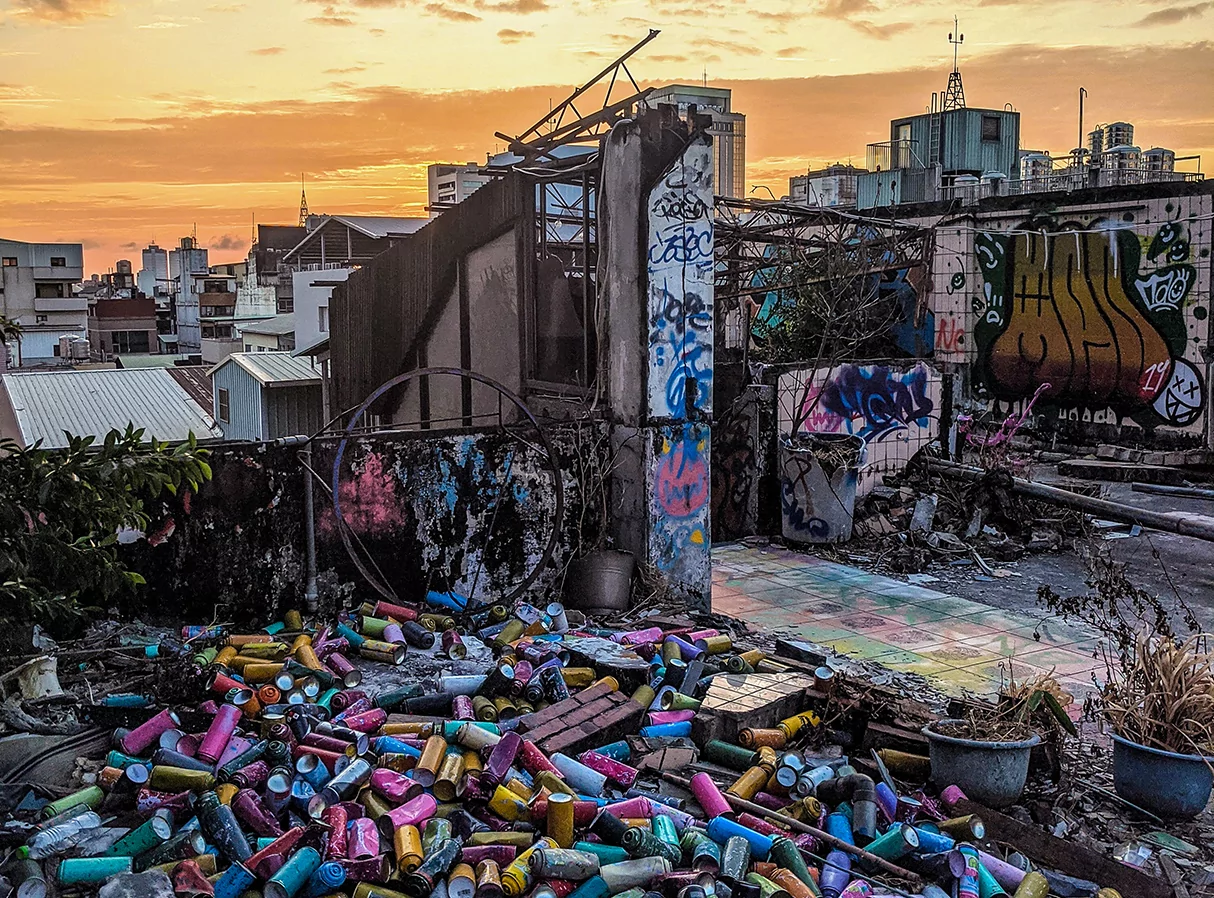
Natural art meets modern art on the rooftop of the Qianyue building as discarded spray paint cans reflect the hues cast by the setting sun
photography by: The Brownes
The 13-storey building (12 above ground and 1 below ground) was built in the late 1970s as a giant complex with residential apartments, restaurants (including the distinctive revolving structure on the rooftop, although some believe this to have been a KTV (karaoke) club), shops, a department store, a nightclub and apparently even an ice rink in the basement.
At the time of its construction and in the two decades that followed, this was a thriving area of the city known as “Electronic Street”, a market area selling all kinds of electronics imaginable and capitalizing on the consumer electronics boom of that era.
However, this area of the city began to decline towards the millennium as Taichung’s business hub moved westwards so the demand for this once-coveted commercial space died away and the building gradually fell into a state of disrepair. A fire destroyed the nightclub on the seventh floor in 2005 and that seemed to spell the end for this building in its original form.

The Qianyue Building from the outside – the remains of the revolving restaurant can be clearly seen at the top of the building
photography by: The Brownes
A collective of graffiti artists called Escape PLAN “X” started spray painting inside the building and eventually (around 2017) got permission from the building owners to paint the fifth and sixth floors, as well as the rooftop. This has now developed into a collaboration between Escape PLAN “X” and Co-X and some of the artists even live in the building, having cleaned up the place considerably and installed utilities on the fifth floor.
For the first time in over 20 years, these floors have running water and electricity and there is an incongruously modern co-working space on the fifth floor. After exploring the first four truly abandoned floors, we did a genuine double-take when we arrived on the fifth floor to find brightly lit hallways and passageways cleared of debris – it is a genuine artists’ oasis in the middle of an otherwise hopelessly degraded building and clearly somewhere they are proud to work and live.
At the time we visited (November 2019), there were no barriers to prevent people entering the building – you can literally walk in from the street. There are a few die-hard shops and traditional restaurants on the ground floor but their occupants largely ignored us as we tentatively stepped inside. We briefly considered the elevator but decided we weren’t that brave so instead began to explore floor by floor, starting at the inner stairwells.
The building is actually two connected buildings with passageways between them so as we peered around the dingy lower floors with the help of a torch, we discovered additional outer stairwells and hidden disused storage rooms at every turn. While there were traces of graffiti in some areas, it was largely bare and stark and we were beginning to wonder should we just call it a day when we found the fifth floor and the real adventure began.
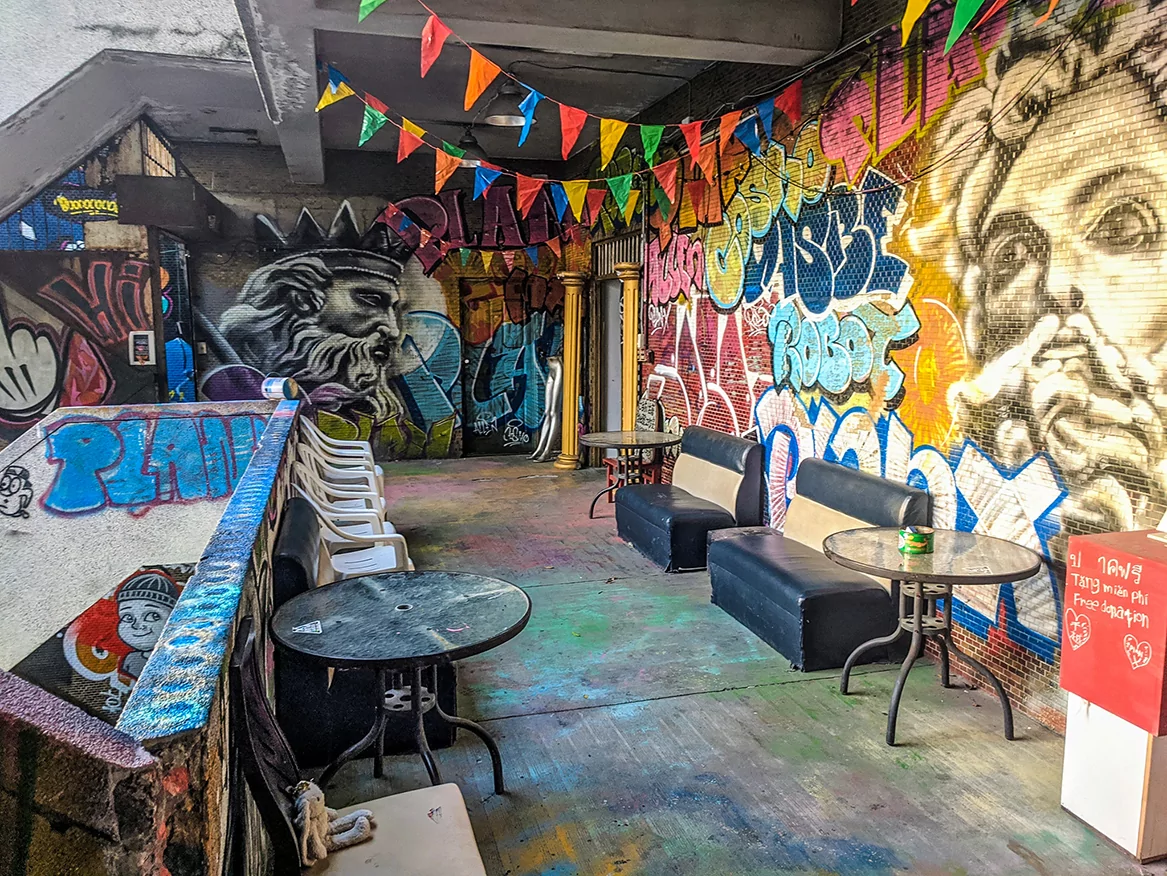
This outer stairwell provides a contrast between the austere industrial architecture and the imagery and artistry now on display here
photography by: The Brownes
This is where things really get interesting. It is hard not to convey meaning to every piece we saw. At first sight, discarded graffiti cans appeared to be just that but on closer inspection, we noticed areas where they appeared to be strategically arranged to reflect a certain color and therefore mood.
One image sticks out in my mind: a bunch of white roses placed in front of a wall of posters featuring the silhouette of the Qianyue building, with a mound of blue paint cans resting against the closed doors of a long-defunct elevator. It almost felt the blue-hued background was a memorial to what once was while the bright white roses signified hope for a future that lay ahead. Powerful imagery was everywhere – from sinister cartoon characters to complex murals depicting scenes from as-yet unwritten animated films.
Everything seemed randomly placed and yet nothing did because it somehow all seamlessly blended together to create an urban art gallery that was both unnerving and inspiring in equal measure.

A world of contrasts: blue cans, white roses and the unmistakable silhouette of the Qianyue building on the posters in the background, and a graffiti painting of a green headed clown
photography by: The Brownes
After almost an hour of exploring and many hundreds of photos, we reached the rooftop. There are technically two rooftops, one from each of the connected buildings. The lower rooftop was where we took some of our favorite sunset photos while the upper rooftop provided an incredible panorama of the city.
There are no guardrails around the edge of the upper rooftop, adding to the ongoing sense of surrealism in a country as concerned about health and safety as Taiwan generally is. We didn’t feel like we were in Taiwan. We didn’t really feel like we were anywhere at that particular moment, just absorbed in the atmosphere of this strange almost-but-not-quite abandoned place.
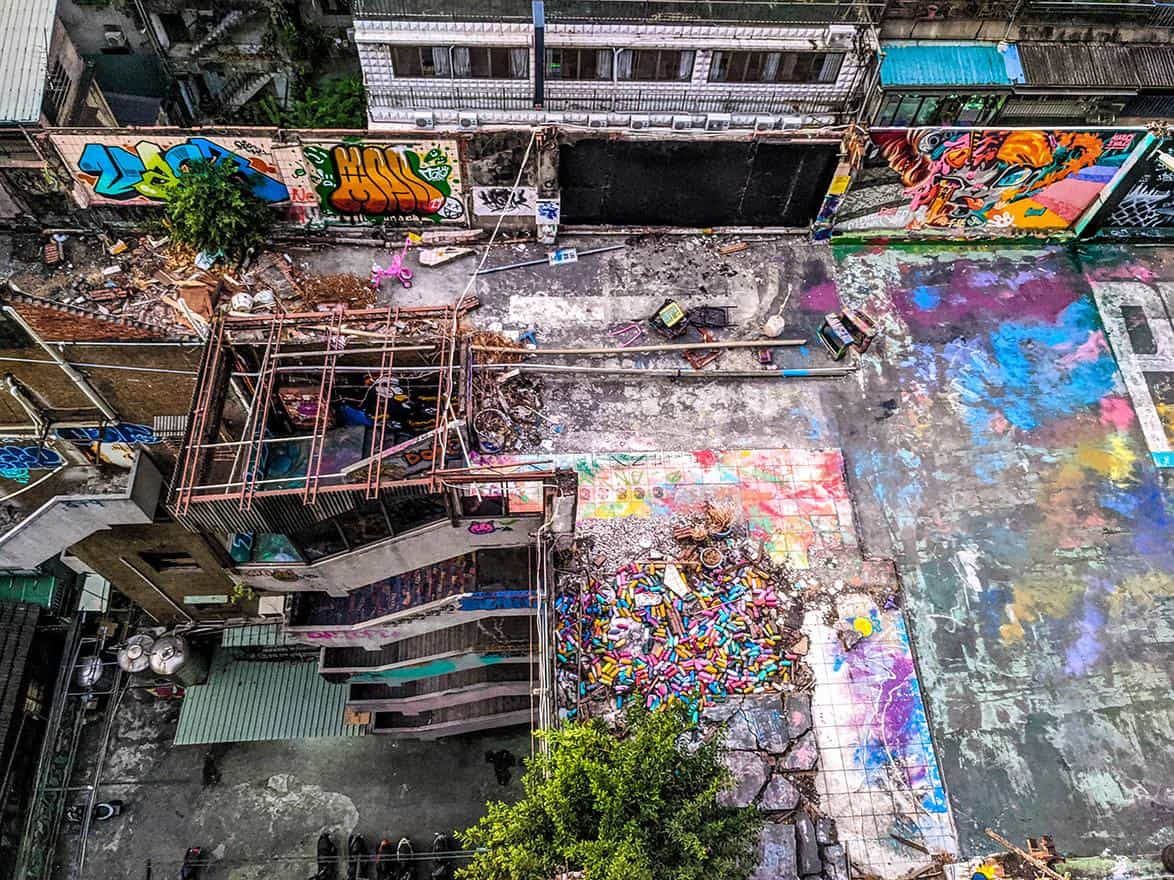
The dizzying view of the lower rooftop from atop the highest accessible point of the building
photography by: The Brownes
While the whole building had captured our attention, this was really the area that fascinated us the most. It was a little dangerous to explore, with parts of the floor completely destroyed and pillars slowly crumbling away but it was impossible not to imagine this in its heyday, full of enthusiastic patrons enjoying a (probably overpriced) drink as the restaurant slowly revolved to give them a 360-degree view of the city.
The most iconic graffiti that I saw in the whole building came from a tiny note scrawled on the window frame of the upper part of the restaurant. It said simply: “WE LEAVE RUINS”. I couldn’t stop thinking about this – whether or not it was intended in this way, I saw it as a metaphor for human life in general and pervasive capitalism in particular. In the name of progress, we develop and redevelop but there are always the ruins to remind us of the people and places that capitalism left behind.
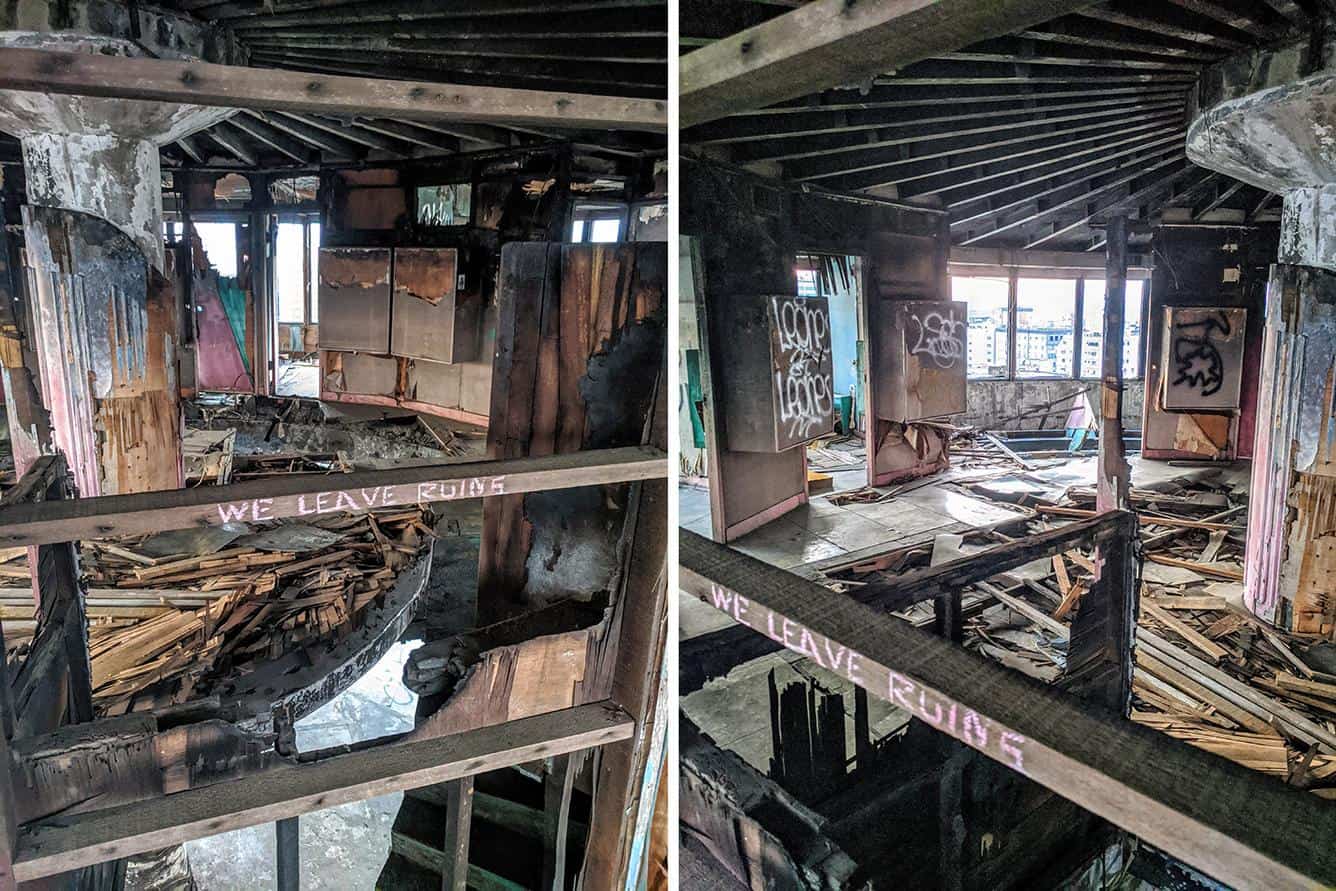
“WE LEAVE RUINS”: a metaphor for human life, perhaps?
photography by: The Brownes
You would expect a place like this to be teeming with tourists but somehow, it isn’t. For most of our visit, we were the only non-residents there. Before we left, a few photographers arrived to set up a photo shoot but up to then it was almost eerily quiet. It all added to the sense of being on the set of a post-apocalyptic movie, where the normal world had disappeared and the cryptic messages staring boldly at us from the walls felt like some sort of clue as to how to preserve life in the depths of destruction and ruin.
If you can, time your visit so that you are there during Golden Hour, shortly before sunset. We didn’t plan our visit around this but we were fortunate enough to be there just at the right time to witness a spectacular sunset from a truly unique location. Give yourself at least an hour or two to explore the building before sunset and bring a torch if you are planning to come back down after dark.
This is, after all, a largely abandoned building and plenty of areas are treacherous in daylight, never mind after dark. The stairs are uneven, the passages are unlit and gaping holes in the floorboards on the uninhabited stories are not uncommon. This is not to discourage you from visiting – I hope that the rest of the article has thoroughly convinced you that this is a must-see part of Taichung – but rather a reminder to come prepared. Trust me, it’s worth it.
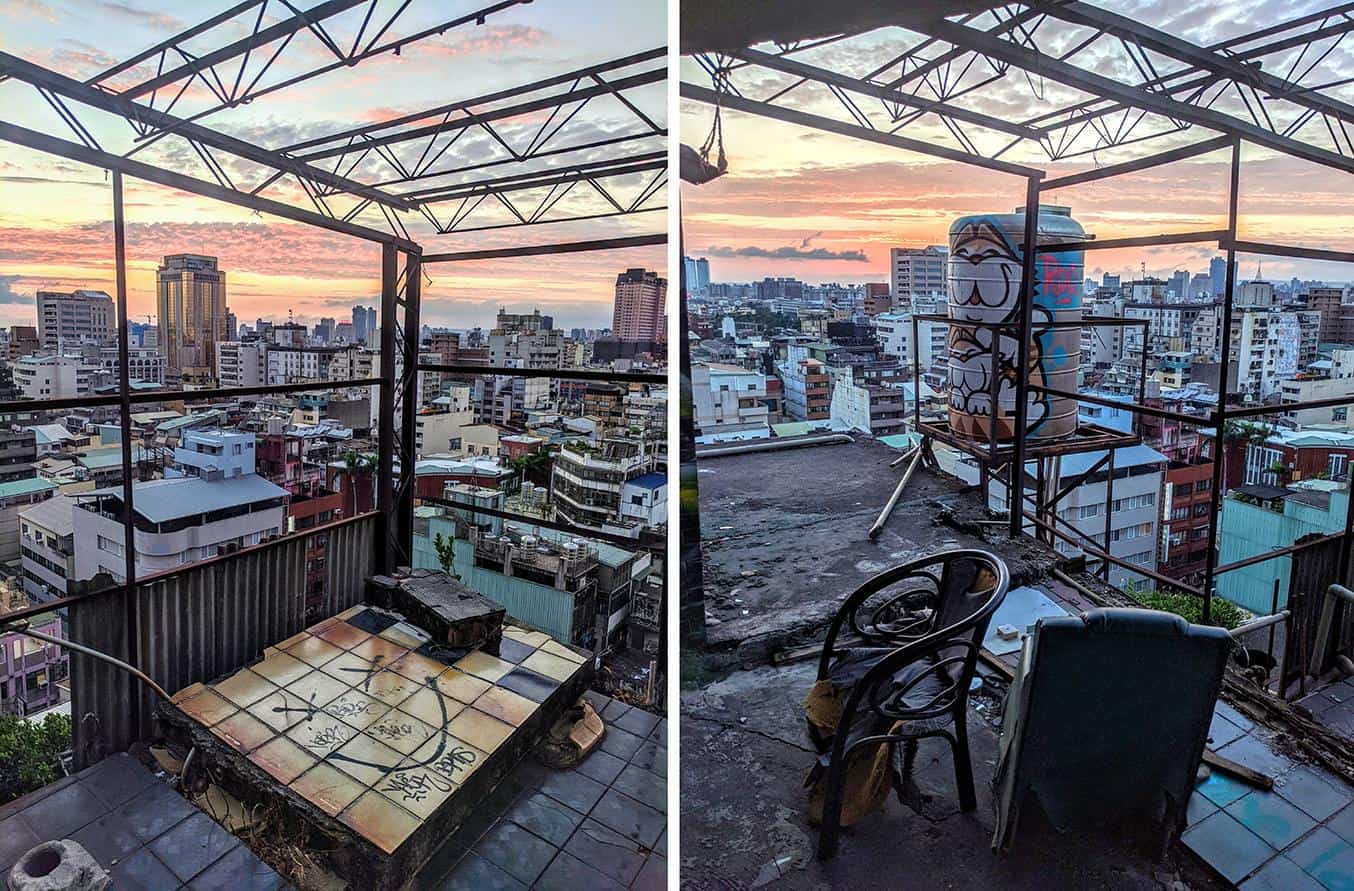
Golden Hour from a unique vantage point – a former bathroom
photography by: The Brownes
As far as we are aware, there are no “official” entrance fees to visit the building. Some people visit and don’t pay at all, some people found a voluntary donation box and others, like us, were approached by some of the artists when exploring the fifth floor.
There was something of a language barrier initially when they asked us for NTD 100 (£2.60 / €3.00 / $3.50) each to visit the building but eventually we understood that this wasn’t some kind of scam and the money goes to the general upkeep of the building and to protect the artists’ IP.
To be honest, this is a very small price to pay for the privilege of getting to explore this unusual art world. Based on a recent post from their Facebook page, there seems to be an issue with a “management committee” on the first floor trying to charge some visitors money.
Escape PLAN “X” is very clear that this is nothing to do with them – the fifth and sixth floors and the rooftop are their domain and unless you are there just to visit the other floors (unlikely), this so-called management committee should not be charging you money.
It is not in any way an exaggeration to say this was one of our favorite discoveries in Taiwan. There is something about the place that stays with you. If you spend enough time here, you almost feel like you will enter a parallel universe because it is just so different to anywhere else in Taichung or even in Taiwan. Here, you have a collective of people that are doing things a little differently.
They are living their lives by their own rules and allowing us the privilege of a glimpse into their private world. They have a message for the rest of us. Yes, “WE LEAVE RUINS” but the fact that there are those among us who use those ruins as foundations for freedom of expression leaves us with a feeling of hope and positivity that lasts long after we walk out of the dilapidated Qianyue building. Rumi, we found the treasure.
Feng Chia Night Market
Taiwan is heaven for foodies and Taichung’s Feng Chia market is one of the best night markets in Taiwan, with mouth-watering dishes on offer for a fraction of the price you would pay in western countries – most dishes cost a couple of dollars at most.
Some of our highlights were Da Chang Bao Xiao Chang (the Taiwanese hot dog – a sausage wrapped in a second rice “sausage”), Tianjing Chong Zhua pancake (a spring onion pancake with a variety of optional fillings) and of course the many types of dim sum including Xiao Long Bao (soft dumplings with delicious soup inside). For the more adventurous, there is always the opportunity to try stinky tofu – to me, the odour resembles what I imagine a marathon runner’s feet smell like post-race so I steered clear!
Rainbow Village
Rainbow Village is a little collection of brightly painted houses and is the work of Huang Yung-Fu, a Chinese soldier who fled with the Kuomintang (Taiwan’s nationalist government who were defeated by the People’s Republic of China) from mainland China to Taiwan in 1949. After he was discharged, he bought a house on land owned by the Ministry of National Defense – part of one of the numerous hastily constructed villages in Taiwan designed to accommodate the influx of 2 million people from China.
Many of these villages were subsequently destroyed. When Huang Yung-Fu heard that the government was planning to demolish his village next, he started painting the walls of his own home and the surrounding buildings. When they saw his work, a group of students petitioned to save these buildings and now, at the age of 98, Huang (known as “Rainbow Grandpa”) still gets up at 3am every day to paint his colourful figures. He even has a little representation of himself amidst them.
Guangfu Junior High-school
The site of the Guangfu Junior High school is now a tourist attraction showing the devastation of the 7.3 magnitude earthquake that hit Taiwan on 21 September 1999. The earthquake happened at 1:47am so the school was empty meaning that thankfully, nobody was injured or killed on the grounds. However, the earthquake resulted in the deaths of 2,415 people in Taiwan and 11,305 were injured in the disaster.
The school has been turned into the 921 earthquake museum to highlight the damage earthquakes can do and as a reminder to be more prepared for such events in future. It’s not hard to imagine how terrifying this earthquake must have been when you see the yawning cracks left on the running track and the oddly tilted remaining buildings surrounded by rubble and ruins.
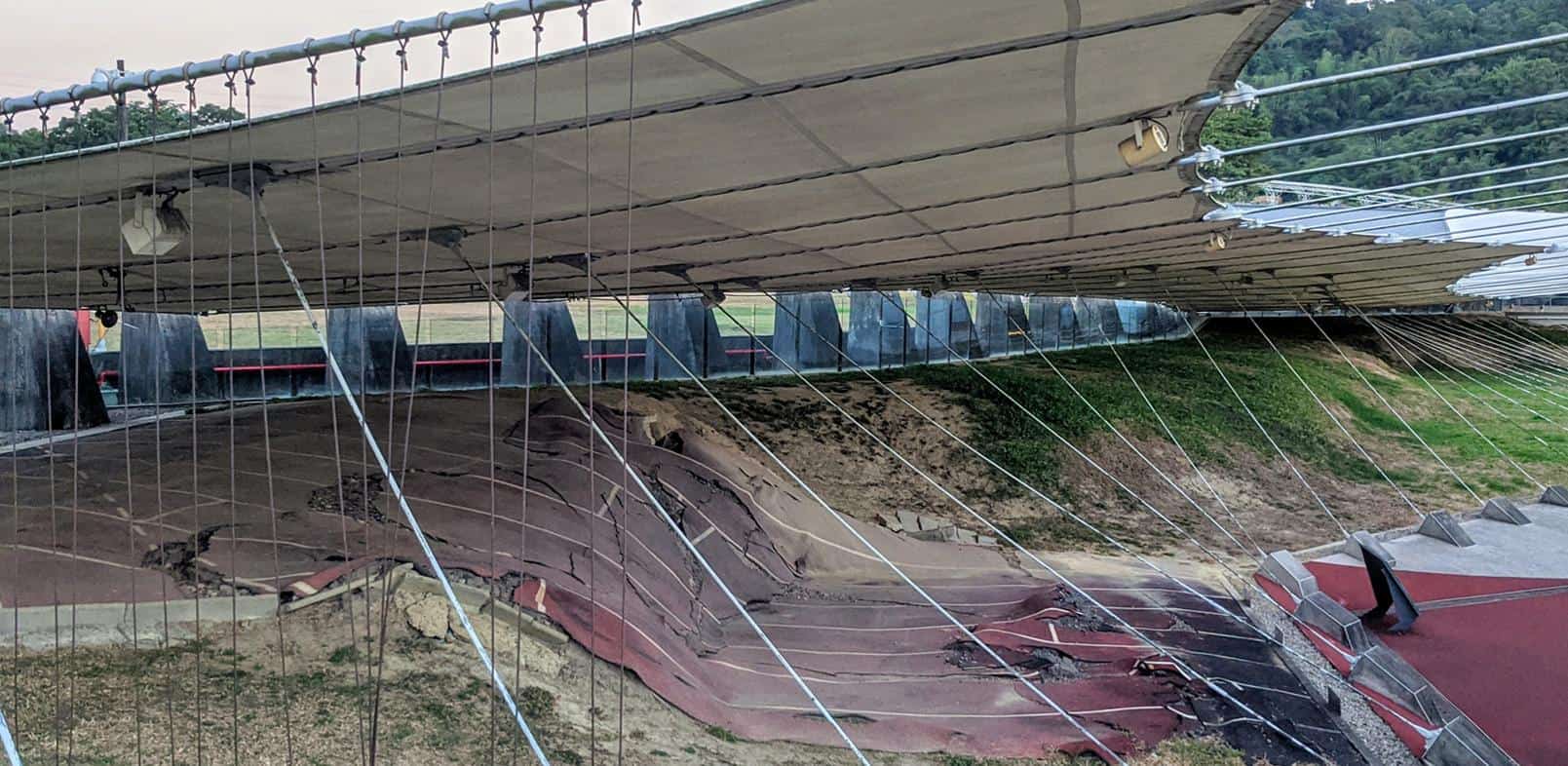
The destroyed running track at Guangfu Junior High School
photography by: The Brownes
Taiwan’s extensive rail and bus network make getting to Taichung extremely easy. The fastest (and most expensive) way is via Taiwan High Speed Rail, with standard fares of NT$675 – NT$700 from Taipei and journey time taking about an hour. A cheaper rail option is via Taiwan Railways Administration, where a fare from Taipei will cost NT$241 (normal) – NT$375 (express) from Taipei and will take 1.5 – 3.5 hours depending on whether you get the express train or not.
The other option is to take one of the many buses operated by various companies. The bus operates at night while the train does not so this option is especially good if you are looking to travel at later hours. The fare is usually NT$220 – NT$280 for a day bus and NT$300 – NT$355 for a night bus with a journey time of 2 to 2.5 hours.
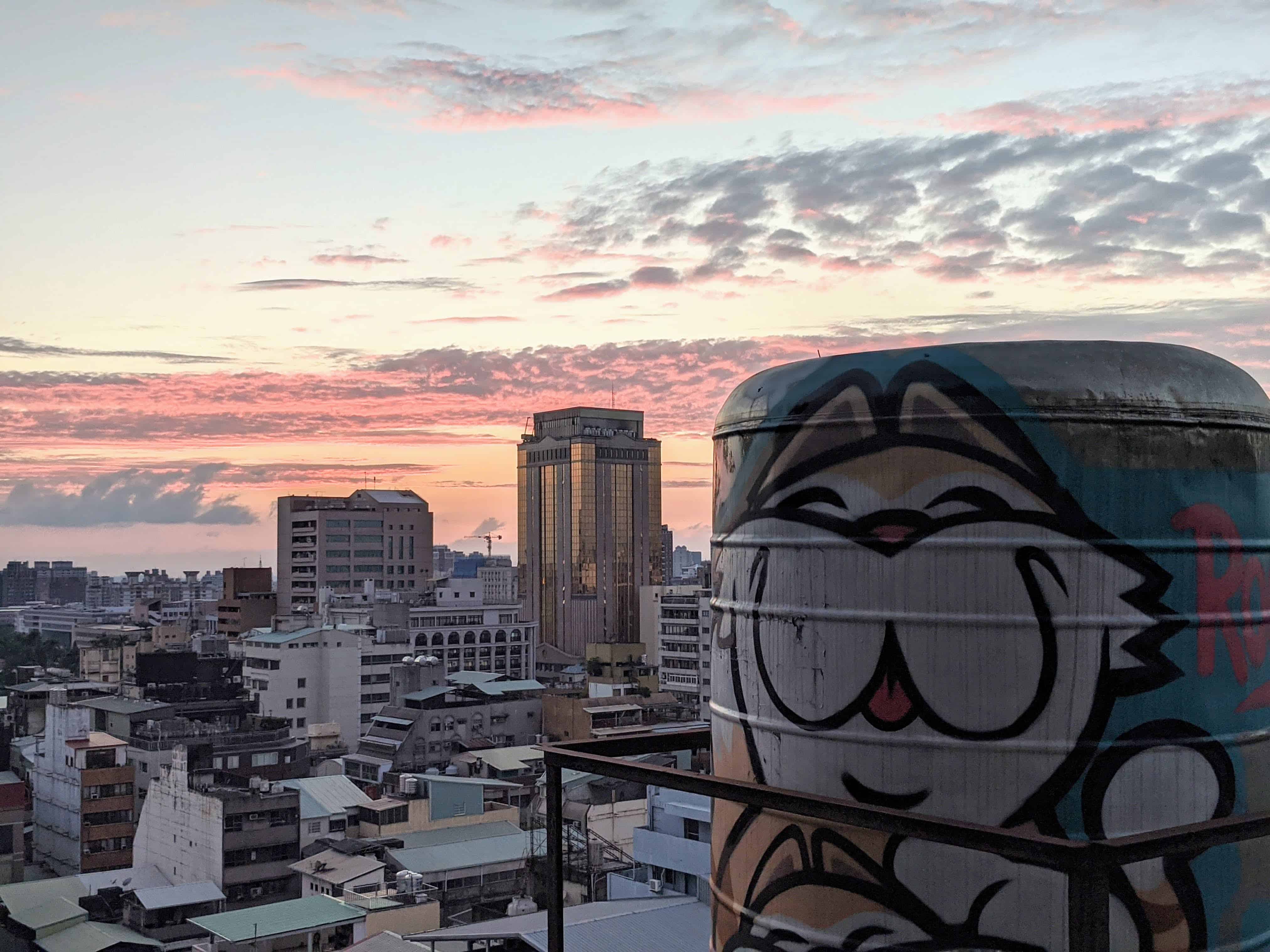
A painted water tank and the city's skyline
photography by: The Brownes
If you search for the building on Google Maps, it may come up with no results. However, it is a very distinctive structure with the rooftop revolving restaurant clearly visible from outside so once you get to the general area, you should be able to see it and find the points of entry. The GPS coordinates are 24.13827, 120.68314 and the street address is: No. 113, Luchuan West Street, Central District, Taichung City, Taiwan 400, the location available at more info.
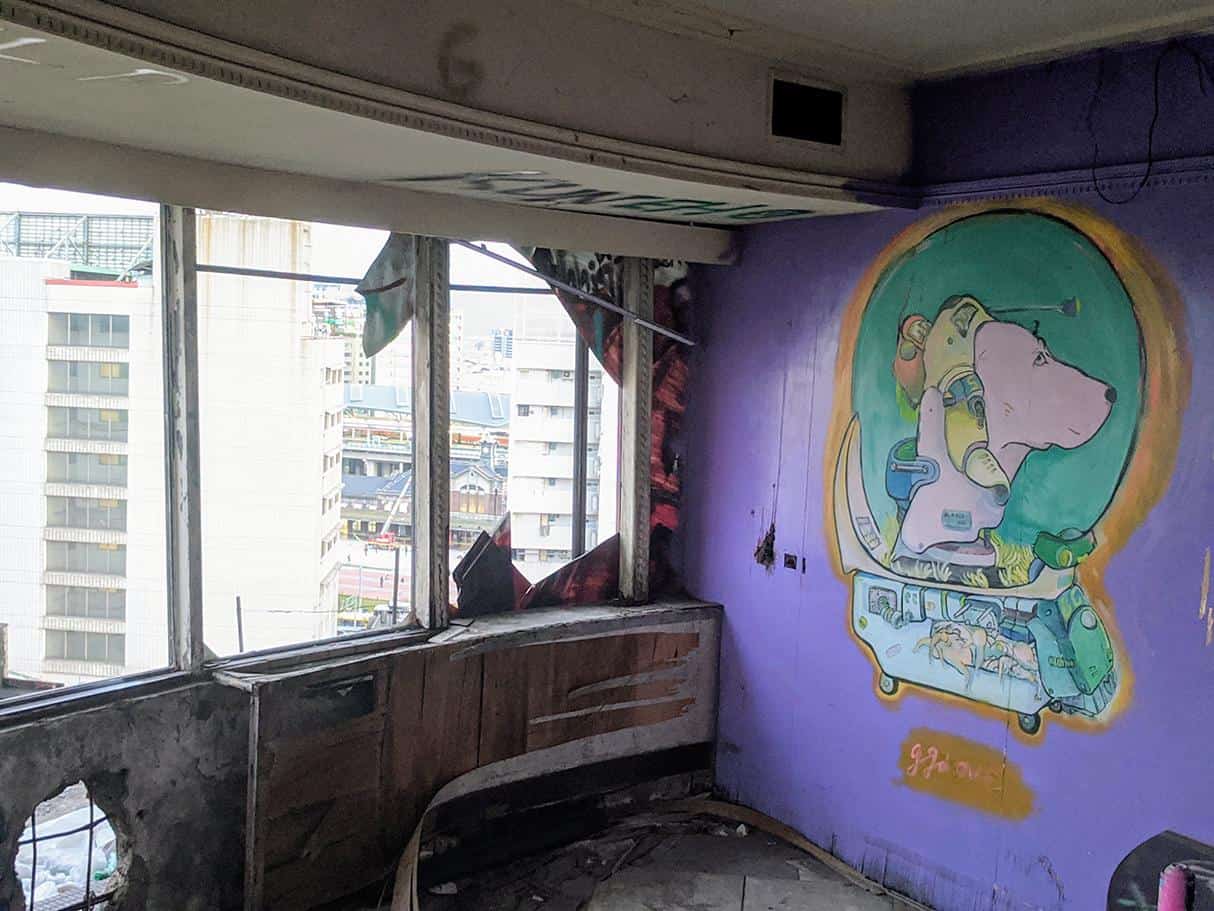
A whimsical graffiti art work alongside Taichung's urban landscape
photography by: The Brownes
We are Sinéad and Adam, an Irish couple with an insatiable appetite for travel. After 6 months exploring South America in 2012, we subscribed to the corporate world for a few years to replenish our travel funds. In 2019, we packed our lives into backpacks once again, this time with no definitive end date and we have since travelled all around South East Asia and Turkey extensively, including an 8 month stay in the Philippines at the height of the COVID-19 pandemic. The travel horizon has changed a lot in the last year but we have a lot more of this wonderful world still to see so we are currently looking into how we can do that in the safest way possible. Life is for living and adventures await.
Instagram: @wherethefeckarewe
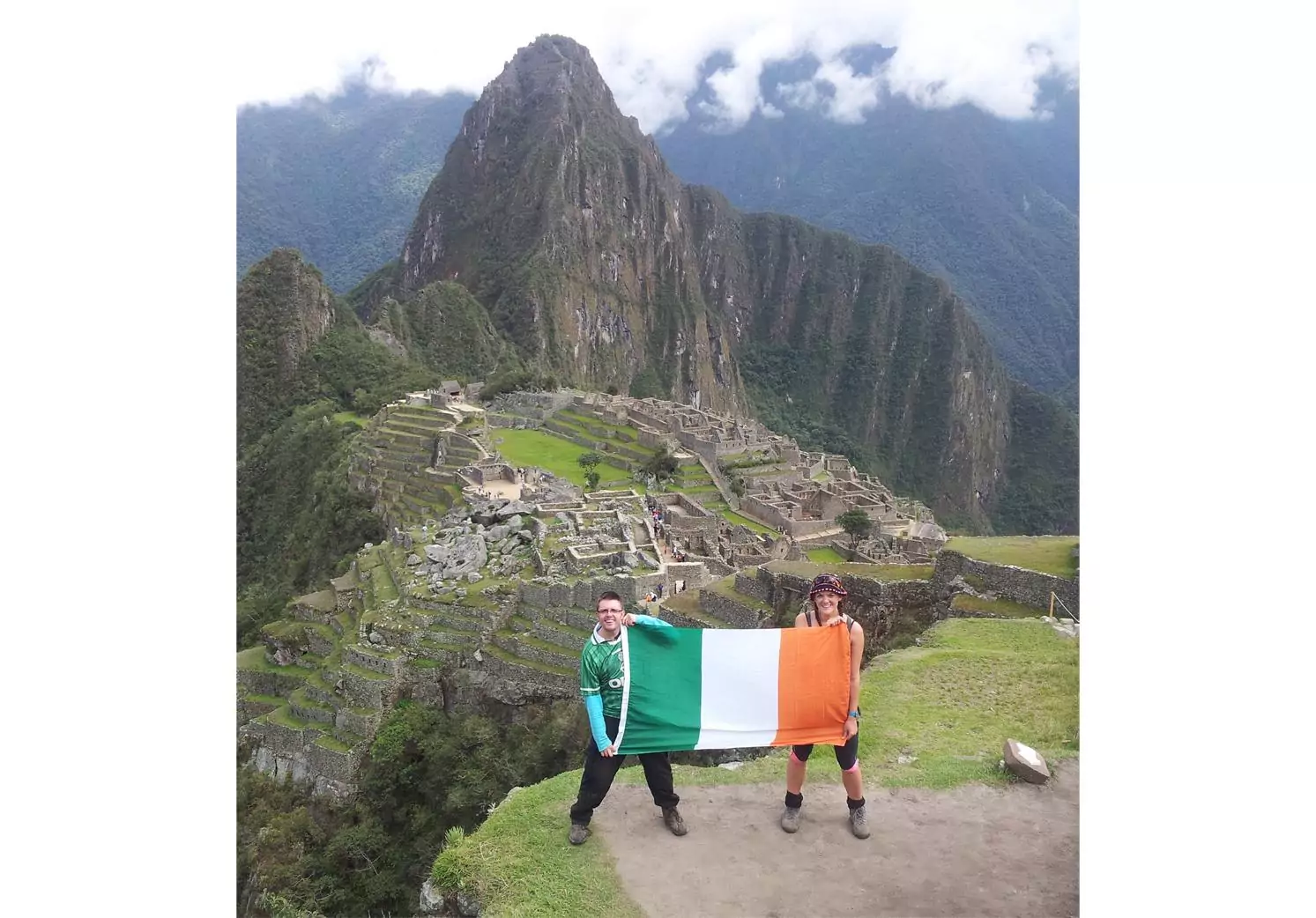
photography by: The Brownes